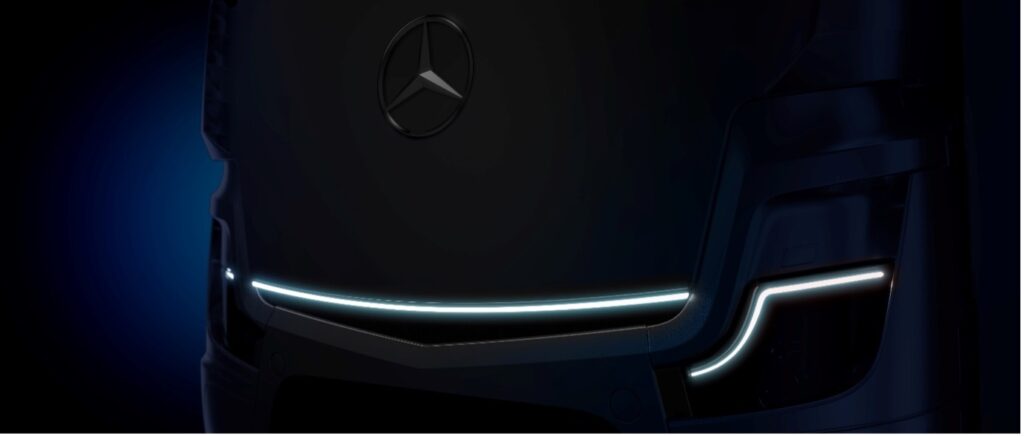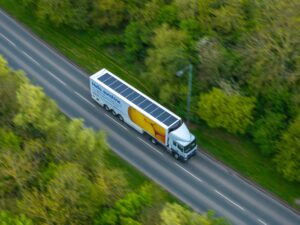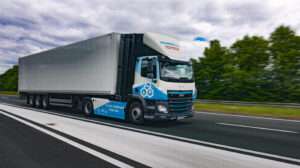Mercedes-Benz Trucks will unveil the eActros LongHaul electric truck for long-distance transport in September at the IAA.
Karin Rådström, CEO of Mercedes-Benz Trucks, commented: ‘The electrification of heavy long-distance transport is the next milestone on our road to CO2-neutrality. The eActros LongHaul is a battery-electric vehicle planned to be economically feasible for our customers. My team and I look forward to presenting this innovative truck to our customers and the public in September.’
IAA Trade Show highlight
The battery-electric eActros LongHaul long-distance truck will be Mercedes-Benz Trucks’ trade show highlight at this year’s IAA Transportation in September in Hanover. The manufacturer announced the 40-tonne truck in 2020 and will present the ‘concept prototype’ precisely two years later for the first time. The eActros LongHaul prototype to be shown at IAA provides a preview of the design theme of the series-production vehicle. The tractor unit is also part of the eActros LongHaul test fleet.
The prototypes are already undergoing intensive testing, and the eActros LongHaul will be tested on public roads this year. Near-production prototypes will get to customers for real-world use testing in the coming year, and series readiness is planned for 2024. The eActros LongHaul will have a range of around 500 kilometres on a single battery charge. The e-truck will enable high-performance charging – or so-called ‘megawatt charging.’
Electric HGVs
In addition to the eActros LongHaul, Mercedes-Benz Trucks will present new battery-electric trucks at IAA. The eActros for heavy-duty distribution transport has been in series production at the Wörth plant since October 2021. The eEconic for municipal use will follow in July. Mercedes-Benz Trucks is pursuing the goal of increasing the proportion of locally CO2-neutral new vehicles in Europe to more than 50% by 2030.
Long battery service life
As part of its pre-launch communications for IAA, Mercedes-Benz Trucks published the first teaser images of the eActros LongHaul concept prototype. It announced further technical specifications planned for the production vehicle. The batteries in the eActros LongHaul employ lithium-iron-phosphate cell technology (LFP). These are characterised, above all, by a long service life and more usable energy. The batteries can charge from 20% to 80% in under 30 minutes at a charging station with an output of about one megawatt. The long-range on a single charge in combination with megawatt charging results in comprehensive ranges on a par with conventional trucks and thus enables two-shift operations.
Driver comfort
An exceptionally well-balanced driveline also characterises the vehicle for an enjoyable driving experience. In addition, the eActros LongHaul features the manufacturer’s numerous safety innovations. The core of the Mercedes-Benz Trucks concept for battery-electric long-distance transport is to offer customers a holistic solution consisting of vehicle technology, consulting, charging infrastructure and services. The eActros LongHaul should be the right choice for customers regarding profitability, sustainability and reliability.
Advantages of the Mercedes-Benz Actros LongHaul
Battery-electric drives have the highest efficiency among alternative drives. The eActros LongHaul, therefore, provides a high level of energy efficiency with its purely battery-electric drive. This gives transport companies significant economic advantages in eActros LongHaul’s intended use scenarios.
The lion’s share of long-distance transport applications in transporters’ operational practices does not require a range beyond the 500km the eActros LongHaul makes possible on a single charge. In addition, legal restrictions on the driving times for truck drivers limit the need for longer ranges, depending on the case. For example, truck drivers in the EU must take a minimum of a 45-minute break after a maximum of 4.5 hours of driving. During this time, energy for the remaining route can be recharged. The eActros LongHaul is, therefore, the right choice for transport companies when used regularly on routes that can be planned, given appropriate distances and charging options.
Engagement with partners for charging infrastructure
Daimler Truck, TRATON GROUP and Volvo Group have signed a binding agreement to establish a joint venture for public charging for long-distance transport. This provides for establishing and operating a public high-performance charging network for battery-electric heavy-duty long-distance trucks and coaches in Europe. The charging network of these three parties should be available to fleet operators in Europe, regardless of brand. Regarding depot charging, Mercedes-Benz Trucks works with Siemens Smart Infrastructure and ENGIE.
In addition, Daimler Truck participates in the “high-performance charging in long-distance truck transport” (HoLa) project. The project’s goal, under the patronage of the VDA, is the planning, construction and operation of a selected high-performance charging infrastructure for battery-electric long-haul trucking. Two high-performance Megawatt Charging System (MCS) charging points will be set up at four locations in Germany and tested for real-world use. Various other consortium partners from industry and research are involved in the project.
Ultimate goal: CO2-neutral transport on the road by 2050
Daimler Truck’s ambition is to only offer new vehicles in Europe, Japan and North America by 2039 that are CO2-neutral when driving (‘tank-to-wheel’). The two battery-electric models, Mercedes-Benz eCitaro and Mercedes-Benz Actros, have been in series production since 2018 and 2021 respectively. The Mercedes-Benz eEconic, the next-generation FUSO eCanter and the Freightliner eCascadia will follow later this year, and other locally CO2-neutral vehicles are already planned. In the second half of this decade, the company aims to add series-production trucks with hydrogen-based fuel cell drives to its range of HGVs. Putting CO2-neutral transport on the road by 2050 is the ultimate goal.




